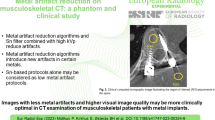Abstract
Software-based metal artefact reduction (MAR) techniques are available to reduce artefacts from cardiac implantable electronic devices (CIED) in the CT data. The impact of disabling MAR techniques on quantification of 18F-FDG uptake around the CIED has not been examined. We consider the importance of enabling MAR in patients with suspected CIED infection to prevent inaccuracies in quantification of tissue tracer uptake on the attenuation-corrected PET images.
Similar content being viewed by others
Explore related subjects
Discover the latest articles, news and stories from top researchers in related subjects.Avoid common mistakes on your manuscript.
Metallic implants produce streak artefacts that can significantly degrade computerised tomography (CT) images by obscuring anatomical structures and pathology (Figure 1A). In positron emission tomography (PET), these artefacts may also propagate to CT-based attenuation maps causing inaccuracies in the quantification of tissue tracer uptake in the attenuation-corrected (AC) PET images. 18F-FDG PET/CT is currently being evaluated in patients with suspected CIED infection, with both visual and semiquantitative measures of 18F-FDG uptake around the pectoral device reported to be of value in differentiating between infection and inflammation.1 Software-based metal artefact reduction (MAR) techniques are available to reduce artefacts from the CIED in the CT data. The impact of MAR on quantification of 18F-FDG uptake around the CIED pulse generator has not been evaluated.2
(A) Low dose CT with streak artefacts from a pre-pectoral CIED. (B) Increased 18F-FDG uptakes increased around the CIED pocket on the AC PET images reconstructed with MAR disabled. (C) No increased 18F-FDG uptake around device on non-AC PET images. (D) Absence of increased 18F-FDG activity in relation to the CIED on with MAR enabled
In the UK, reimbursement for non-oncological FDG PET/CT is provided for examinations that fall within the evidence-based indications for PET-CT.3 In this case of a patient with pain in the region of the CIED generator pocket, increased 18F-FDG uptake was noted around the device pocket on the AC PET images reconstructed with MAR disabled (Figure 1B). However, this increase was not apparent on the non-AC images (Figure 1C). Reconstructing the PET data with MAR enabled confirmed the absence of increased activity in relation to the device (Figure 1D). Studies using a torso phantom with CIED/pacing leads and typical patient FDG activity verified these findings.4 To conclude, when the region of interest is the CIED, MAR algorithms should be enabled to reduce the risk of erroneously increased tracer uptake, which may inaccurately infer the presence of infection or inflammation.
References
Sarrazin JF, Philippon F, Tessier M, Guimond J, Molin F, Champagne J, et al. Usefulness of fluorine-18 positron emission tomography/computed tomography for identification of cardiovascular implantable electronic device infections. J Am Coll Cardiol 2012;59:1616-25.
Ghafarian P, Aghamiri SM, Ay MR, Rahmim A, Schindler TH, Ratib O, et al. Is metal artefact reduction mandatory in cardiac PET/CT imaging in the presence of pacemaker and implantable cardioverter defibrillator leads? Eur J Nucl Med Mol Imaging 2011;38:252-62.
The Royal College of Physicians and Royal College of Radiologists. Evidence based indications for the use of PET-CT in the UK. London: RCP, RCR, 2013. http://www.rcr.ac.uk/docs/radiology/pdf/2013_PETCT_RCP_RCR.pdf.
James J, Tout D, Ahmed FZ, Arumugam P, Zaidi A, Prescott M. 18F-FDG PET CT imaging for infected cardiac implantable electronic devices (abstract). Eur J Nucl Med Mol Imaging 2013;40:89-565 (Abstract number OP325).
Acknowledgments
Fozia Z. Ahmed is a research fellow supported by a research grant from Medtronic.
Disclosures
Fozia Z. Ahmed is a fellow supported by a research grant supported by Medtronic. No other disclosures.
Author information
Authors and Affiliations
Corresponding author
Rights and permissions
About this article
Cite this article
Ahmed, F.Z., James, J., Tout, D. et al. Metal artefact reduction algorithms prevent false positive results when assessing patients for cardiac implantable electronic device infection. J. Nucl. Cardiol. 22, 219–220 (2015). https://doi.org/10.1007/s12350-014-9955-8
Received:
Accepted:
Published:
Issue Date:
DOI: https://doi.org/10.1007/s12350-014-9955-8





